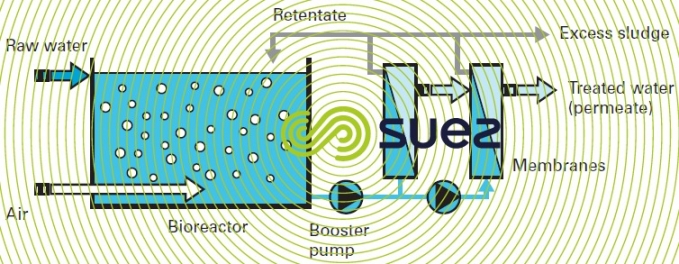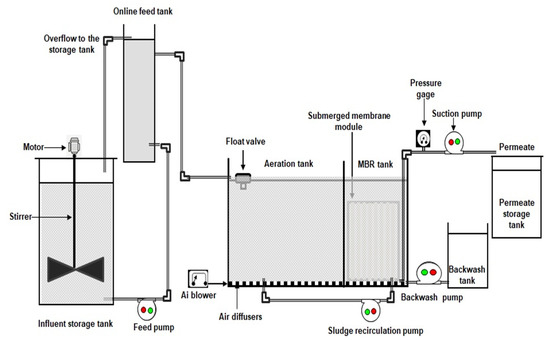How Membrane Bioreactor Can Help Meet Stringent Environmental Regulations
How Membrane Bioreactor Can Help Meet Stringent Environmental Regulations
Blog Article
The Advantages of Membrane Layer Bioreactors in Sustainable Wastewater Monitoring
Membrane bioreactors (MBRs) stand for an essential development in lasting wastewater administration, efficiently combining organic therapy with sophisticated membrane purification technology. As the need for lasting solutions intensifies, discovering the diverse benefits of MBRs may disclose unexpected effects for the future of wastewater therapy systems.
Review of Membrane Bioreactors
Membrane layer bioreactors (MBRs) stand for a substantial improvement in wastewater therapy technology, integrating organic deterioration with membrane purification to improve the effectiveness of the therapy procedure. This cutting-edge system incorporates the benefits of standard triggered sludge procedures with membrane innovation, enabling for boosted solid-liquid splitting up. MBRs use semi-permeable membrane layers to different cured water from biomass, causing top notch effluent that can be recycled or safely released right into the atmosphere.
The operational layout of MBRs normally involves a bioreactor where microorganisms break down raw material, followed by a membrane device that filters the combined alcohol. This configuration not just reduces the impact of the therapy center yet additionally enables for higher biomass focus and minimized hydraulic retention times. In addition, MBRs are qualified of dealing with a larger range of pollutants, consisting of nutrients and virus, making them ideal for different applications, from local wastewater treatment to industrial effluent processing.
The combination of MBRs into wastewater monitoring systems is indicative of a growing trend in the direction of sustainable and effective practices in environmental engineering. Their capability to produce premium effluent while decreasing area demands placements MBR technology as a key gamer in modern-day wastewater treatment remedies.
Improved Effluent Top Quality

The membrane filtration procedure works as a physical barrier, enabling the retention of microbes and particle matter, which contributes to a clearer and cleaner effluent (Membrane Bioreactor). Furthermore, MBRs operate at greater biomass concentrations than conventional turned on sludge systems, advertising much more efficient biodegradation of toxins. This results in a decrease in biochemical oxygen demand (BOD) and overall suspended solids (TSS) levels in the final effluent
Additionally, MBRs demonstrate exceptional efficiency in treating challenging wastewater compositions, such as industrial effluents and wastewater with high nutrient tons. As an outcome, the effluent produced is often of better, permitting more versatile disposal choices and reduced ecological influence. Eventually, the enhanced effluent quality attained with MBR technology emphasizes its crucial duty beforehand sustainable wastewater monitoring techniques.
Water Reuse Opportunities
The high-quality effluent generated by membrane layer bioreactors (MBRs) opens significant possibilities for water reuse in different applications. MBRs efficiently eliminate pollutants, consisting of virus, suspended solids, and raw material, resulting in treated water that fulfills or surpasses regulatory criteria for reuse. This high quality enables the application of water recycling campaigns throughout varied sectors.
One famous application remains in agriculture, where treated wastewater can be used for irrigation, advertising sustainable farming techniques while preserving freshwater sources. Furthermore, MBR-treated effluent can be utilized for industrial procedures such as cooling, cleaning, and as a procedure water resource, considerably reducing the need for drinkable water in these procedures.
In city environments, MBRs assist in the use of recovered water for landscape watering, toilet flushing, and various other non-potable usages, contributing to the total durability of water system systems. Additionally, the assimilation of MBR technology in decentralized systems help in handling local water needs, especially in water-scarce regions.
Lowered Environmental Effect
Exactly how can the adoption of membrane layer bioreactors (MBRs) contribute to a lowered environmental effect in wastewater management? MBRs substantially improve the treatment effectiveness of wastewater while lessening ecological disturbances. By integrating organic therapy processes with membrane filtering, MBRs successfully remove a variety of contaminants, including natural matter, nutrients, and virus. This sophisticated purification brings about higher-quality effluent, which is important for safeguarding aquatic ecosystems and minimizing the concern on all-natural water bodies.
Additionally, MBRs run at lower hydraulic retention times contrasted to traditional systems, leading to smaller treatment plant footprints. This portable design minimizes land use, consequently protecting natural habitats and biodiversity. The process likewise generates much less sludge than typical methods, mitigating disposal obstacles and decreasing greenhouse gas emissions related to sludge monitoring.
Additionally, MBRs facilitate the recovery of beneficial resources, such as water and nutrients, adding to a circular economy. By allowing water reuse for irrigation or industrial processes, MBRs aid alleviate freshwater scarcity, therefore promoting lasting water utilize methods. Inevitably, the fostering of MBR modern technology represents a substantial stride in the direction of decreasing the environmental impact of wastewater monitoring systems.
Financial Benefits of MBRs

In addition, MBRs facilitate the manufacturing of high-quality effluent, which can be reused for different applications, such as agricultural irrigation and commercial procedures - Membrane Bioreactor. This reuse capacity can significantly decrease water purchase prices, giving a financial incentive for industries encountering review rigorous water guidelines
The portable layout of MBR systems additionally leads to decreased land requirements, which is particularly beneficial Extra resources in urban locations where property is expensive. By reducing space, industries and districts can save money on land purchase and maintenance expenditures.
Moreover, MBRs usually need less constant upkeep and have a longer lifespan than conventional systems, further adding to cost financial savings. In recap, the economic benefits of MBRs-- ranging from reduced functional costs to land financial savings and effluent reuse-- make them a compelling choice for lasting wastewater administration, offering both lasting and instant financial advantages.
Conclusion
Membrane bioreactors represent a transformative strategy to sustainable wastewater administration, incorporating biological treatment with innovative membrane filtration for exceptional effluent top quality. Their capacity for efficient impurity removal assists in water reuse, consequently conserving essential freshwater sources. In addition, MBRs contribute to decreased ecological influences through portable layouts and lower sludge generation. Economic advantages even more improve their stability, making MBRs an appealing option for addressing the challenges of wastewater treatment and promoting sustainable source great post to read management.
Membrane layer bioreactors (MBRs) stand for an essential innovation in lasting wastewater administration, properly combining organic treatment with advanced membrane filtration technology.Membrane bioreactors (MBRs) represent a substantial innovation in wastewater therapy innovation, integrating biological degradation with membrane layer purification to improve the effectiveness of the treatment process.Attaining boosted effluent high quality is one of the most considerable benefits of making use of membrane bioreactors (MBRs) in wastewater treatment.Additionally, MBRs show exceptional performance in dealing with difficult wastewater structures, such as industrial effluents and wastewater with high nutrient loads.Incorporating membrane bioreactors (MBRs) right into wastewater administration not only decreases environmental impact however also presents significant economic advantages.
Report this page